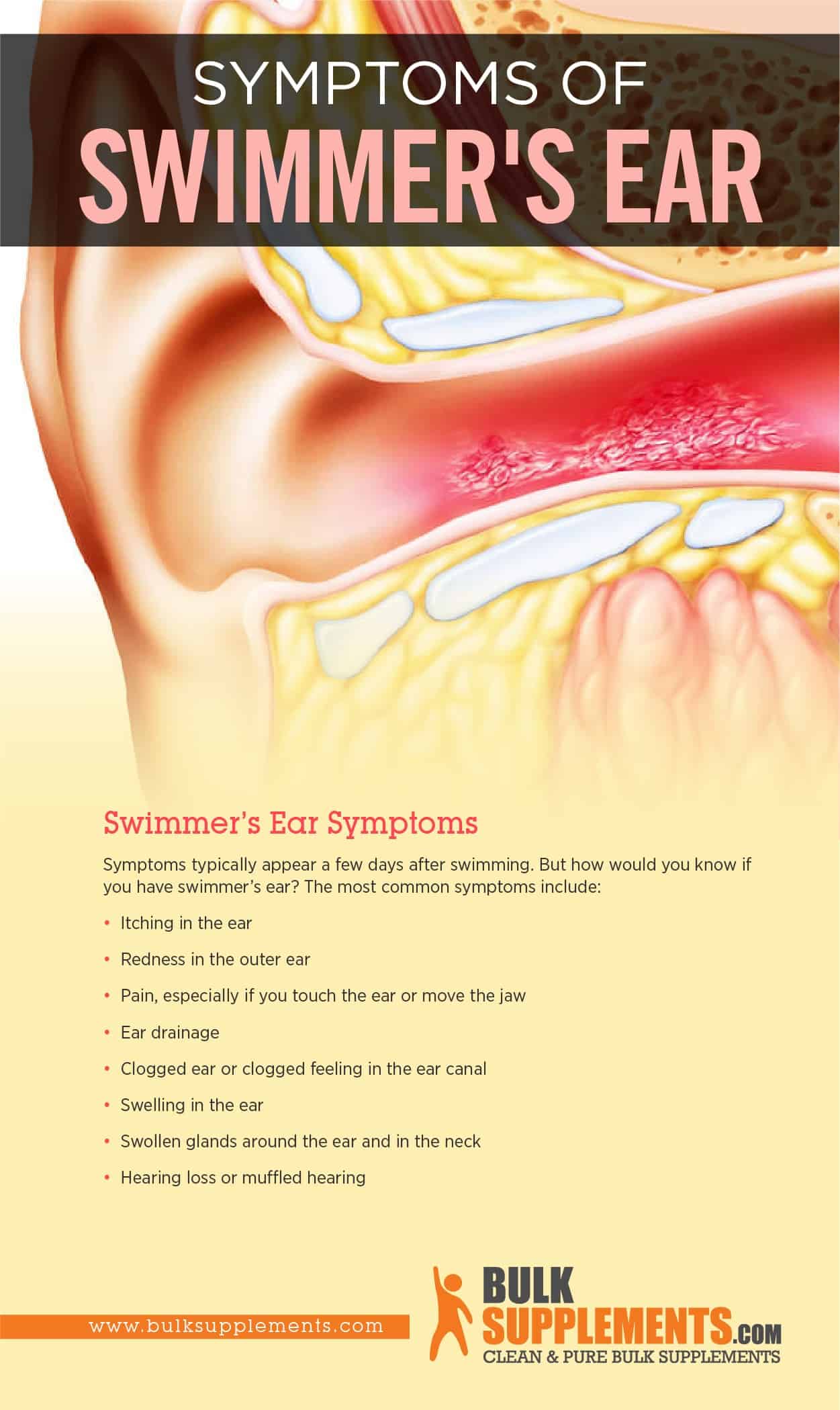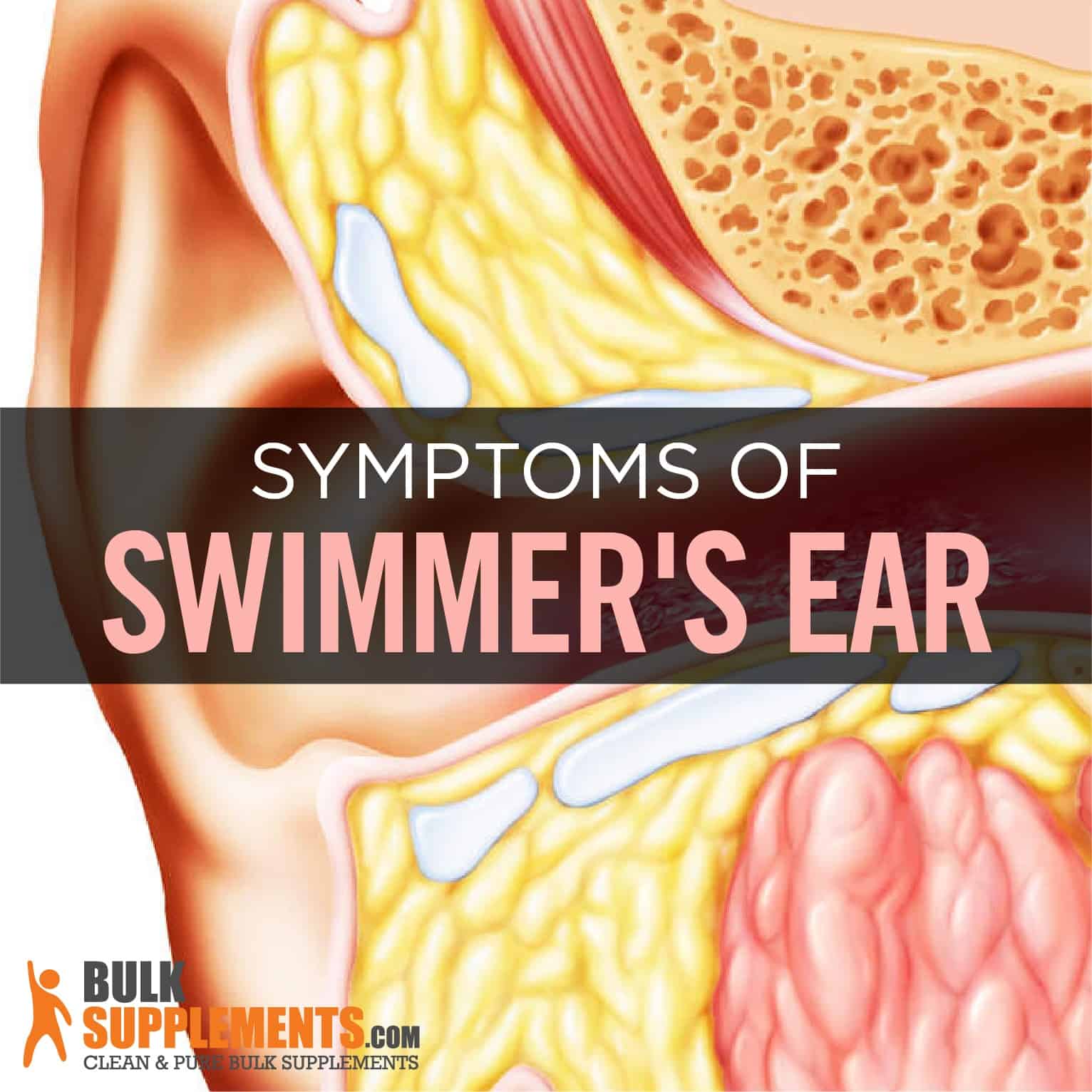What is Swimmer’s Ear?
Common in the summer season, swimmer’s ear is an ear infection that affects at least one in 123 people in the United States every year (x). Also known as otitis externa, swimmer’s ear is an infection in the outer ear canal caused by a fungus or bacteria. Anyone can get the infection, but most diagnoses are in children between the ages of 5 and 9 (x). Swimmer’s ear got its name because it is often caused by germs found in pools and other places where people swim. These places make it easy for germs to enter the ear, making it common among people who swim frequently (x, x).
Swimmer’s ear is often confused with middle ear infections, which usually develop in children (x). Middle ear infections are in the middle of the ear, while swimmer’s ear is an infection in the outer ear and the ear canal. Additionally, middle ear infections usually don’t cause pain, but swimmer’s ear does (x).
Swimmer’s Ear Symptoms
Symptoms typically appear a few days after swimming (x). But how would you know if you have swimmer’s ear? The most common symptoms include (x):
- Itching in the ear
- Redness in the outer ear
- Pain, especially if you touch the ear or move the jaw
- Ear drainage
- Clogged ear or clogged feeling in the ear canal
- Swelling in the ear
- Swollen glands around the ear and in the neck
- Hearing loss or muffled hearing
Swimmer’s Ear Causes
Swimmer’s ear is more common than some people may think. About 10 percent of people will develop an outer ear infection at some point (x). One myth about this infection is that it only results from frequent swimming. While this is one cause, there are actually a few different ways a person may develop it.
Bacteria
Water itself is not to blame for the infection. Rather, it is the bacteria in the water that causes most cases of it (x). If water gets stuck in your ear and the ear stays moist, it creates an environment for germs and bacteria to grow (x). People who have small ear canals are more prone to infection because they do not drain as well (x). If you do end up with water in your ear, you can get rid of it by tilting your head, pulling on your earlobe or holding a hair dryer a few inches from the ear on a low setting until it feels dry (x).
Fungus or Virus
Usually, it is caused by bacteria, but sometimes it develops from a fungal infection — such as a yeast infection — or a virus, like the flu (x).
Ear Injury
Someone who has had a minor injury to their ear canal is more likely to develop it. Inserting anything into the ear canal can cause damage — for example, trying to clean the ear with a cotton-tipped swab or frequently wearing in-ear headphones or earplugs (x, x).
Allergic Reactions
Some people have allergies to certain types of soaps and shampoos that may also cause some cases of it (x). Along similar lines, skin conditions like eczema and psoriasis increase the risk of infection if they affect the ear canal (x).
Moisture and Humidity
When the ear canal is exposed to moisture or humidity, such as a shower or a bath, the skin becomes soft and vulnerable to damage or infection. Moisture can wash away the protective lining of earwax that wards off infection (x, x).
Chemicals
The bacteria can also grow if chemicals come into contact with the ears, such as hairspray, shampoo or hair dye. They can irritate the ear canal and disturb the lining that protects it from infection (x).

Preventing Swimmer’s Ear
It is possible to prevent swimmer’s ear by taking precautions that lower the risk of infection, including:
- Keeping the ears as dry as possible with shower caps, swim caps or ear plugs (x)
- Drying the ears after swimming or showering (x)
- Keeping objects out of the ear canal (cotton-tipped swabs, fingers, paperclips, pencils) (x)
- Avoid removing ear wax because it protects your ear canal against infections (x)
- Removing water from the ear by tilting your head to the side, gently pulling on your earlobe or jumping up and down (x)
- Checking the pH levels of pools and hot tubs to decrease the likelihood of coming in contact with germs (x)
- Using alcohol-based ear drops to reduce moisture, correct pH balance and keep bacteria from growing in the ear (x)
- Avoiding in-ear headphones if you have sensitive ear canals (x)
Swimmer’s Ear Treatment
If it is treated properly, swimmer’s ear tends to improve within seven to 10 days (x). Physicians usually treat the infection using ear drops with antibiotics, corticosteroids to reduce swelling, pain medication or acetic acid drops to prevent future infections (x, x). Doctors recommend that patients avoid going underwater while the infection is being treated. However, competitive swimmers and divers may be able to enter the pool with earplugs if there is no pain (x).
Supplements for Swimmer’s Ear
While swimmer’s ear is usually treated with prescription ear drops, there are other more natural remedies available that can get rid of swimmer’s ear and its accompanying symptoms.
Curcumin
Because of its anti-inflammatory properties, curcumin can reduce the swelling and inflammation associated with swimmer’s ear. The recommended dosage is 1,000 mg per day with food or water.
Garlic Extract
One of the active ingredients in garlic, allicin, has natural antibacterial and antiviral properties that can remedy swimmer’s ear, which is often caused by viruses or bacteria (x). As a supplement, use garlic extract twice a day with a meal in doses of 650 mg.
Ginger Root
With anti-inflammatory and antibiotic properties, ginger root is another natural remedy for outer ear infections (x). The recommended dosage is 1,000 mg once per day, with water to avoid heartburn.
Holy Basil Powder
Derived from a plant that grows in eastern countries, holy basil is an anti-inflammatory and can relieve swimmer’s ear symptoms. The recommended serving size is 500 mg once or twice a day.
Omega 3-6-9 Softgels
Fatty acids such as Omega 3-6-9 are rich in anti-inflammatory properties. They can also prevent cardiovascular disorders, cancer and rheumatoid arthritis (x).
The Bottom Line
Swimmer’s ear is a common infection caused by fungi or bacteria that grow in moist environments. Though it is associated with people who swim frequently, it can develop in anyone who gets water stuck in their ears, has allergic reactions or suffers minor injuries to the ear canal that lead to infection. The bacteria can grow and spread in any wet or humid environment, including pools, showers and bathtubs.
It presents a number of symptoms — itchiness, redness, pain and swelling. Wearing swim or shower caps, drying your ears after swimming or showering and keeping objects out of the ears can prevent swimmer’s ear. Treatment includes ear drops along with other natural remedies that provide anti-inflammatory, antibacterial and antiviral effects.


